Everyone has seen those awful comb-overs and wonder how people get there. First, it is important to note these men did not wake up one morning, see that they were bald and then decide to grow out the hair above their ears to comb back to the other side. Politicians are frequently seen with these bizarre comb-overs. They develop insidiously over time. First a little hair loss, and the person starts combing their hair from one side to the other. The ‘part’ moves down over time as the hair by the ‘part’ grows longer and longer. For the first few years, this trick of styling with the patient’s own hair works well, even as the hair loss progresses, but sooner or later, the comb-over starts to become obvious as the balding area enlarges so much that the hair can not cover it. Because the change occurs each and every day over years, the person who uses the comb-over doesn’t notice it. Even their wives don’t see it, nor do many of those in a close family. If the comb-over is really bad (I see them at the theaters all of the time), friends and family don’t want to touch the subject, so these poor men just don’t know how they look. This is a classic psychological term called “denial”. These men think hairs, and they are hairy, no matter what anyone says.
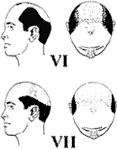 Alternatively, some men create bouffants, a puffed up hairdo which is made up by very long hair that is wrapped around the top of the head to look like a normal head of hair. Some of these bouffants are truly amazing and they have often fooled me when they came into the office. Most of these man are either Class 6 or 7 patients and they work the frontal hair, hair by hair, to stick to the upper part of the forehead and combing the hair from behind to a forward direction so that the actual hairline does not show. I remember one man who took it one step further — he cut his hair and let it settle on his bald scalp. I am not sure how it started, but when I saw him, he had a pile of loose hairs, held by the dirt and grime of Los Angeles, to the bald area of his scalp. It worked, at least for the top and crown of his head, but not for the front of his head. This poor man never washed his hair, because the hair would all go down the drain. He used a type of perfume to neutralize any odor from his hair, which actually smelled musty.
Alternatively, some men create bouffants, a puffed up hairdo which is made up by very long hair that is wrapped around the top of the head to look like a normal head of hair. Some of these bouffants are truly amazing and they have often fooled me when they came into the office. Most of these man are either Class 6 or 7 patients and they work the frontal hair, hair by hair, to stick to the upper part of the forehead and combing the hair from behind to a forward direction so that the actual hairline does not show. I remember one man who took it one step further — he cut his hair and let it settle on his bald scalp. I am not sure how it started, but when I saw him, he had a pile of loose hairs, held by the dirt and grime of Los Angeles, to the bald area of his scalp. It worked, at least for the top and crown of his head, but not for the front of his head. This poor man never washed his hair, because the hair would all go down the drain. He used a type of perfume to neutralize any odor from his hair, which actually smelled musty.
So styling, which works for slight hair loss and is very commonly used, is modified over and over again as the hair loss progresses. As over 50% of women over the age of 60 have significant hair loss, the use of puffing up styles, allow the appearance of more as their balding becomes worse. Just go to a retirement community and you will see what I mean. If you realize than almost 50% of men and women over 45 have hair loss, most of them are using styling tricks to make their hair look fuller. Hair thickeners, gels and special hydrating shampoos will increase the thickness of each hair shaft.
It should be clear to regular readers of this site that hair transplantation rarely brings back the hair to normal densities. So the same tricks that are used in those with thinning hair are used by those people who have had hair transplants. On very rare occasions, I have returned the transplanted area to an almost normal density, but that is more the exception to the rule than what I normally do. Many hair transplant doctors would like you to think that you really get your hair back, but that is not the case. I have selected four patient examples with estimates of the actual range of density that they have obtained from hair transplantation. The reason that one might get a higher density return is because the supply is more than adequate to address the balding area demand.
Patient #1 has returned about 80% of his original density at great cost to his donor supply, which has become a bit depleted. His hair is very fine, so more density was necessary for his to get his crew cut hair style.
Patient #2 uses a puffed up hair style to create the illusion of hair (he has less than 15% of his original density replaced and is a full Class 6 patterned balding patient).
Patient #3 is a full Class 6/7 balding pattern and combs his hair backward to cover the balding in the crown.
Styling is part of a hair transplant process which you and your doctor should discuss as part of his informed consent. It is a process that balding men, sooner or later will adopt if they want to look hairier.
![]()
![]()



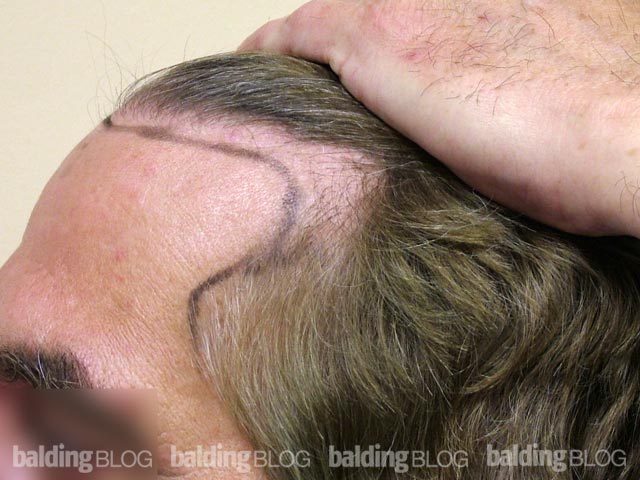
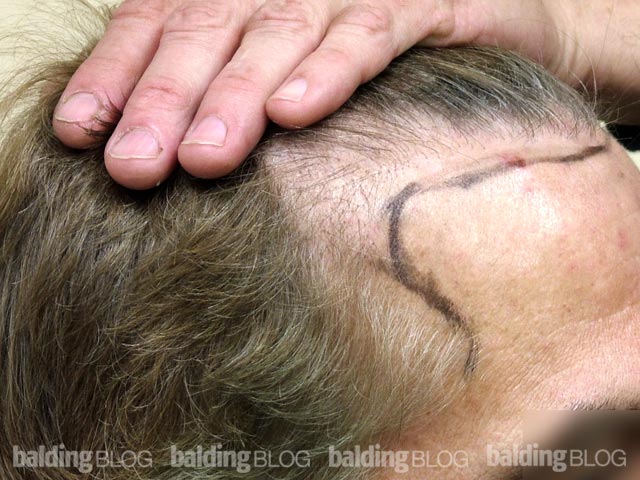
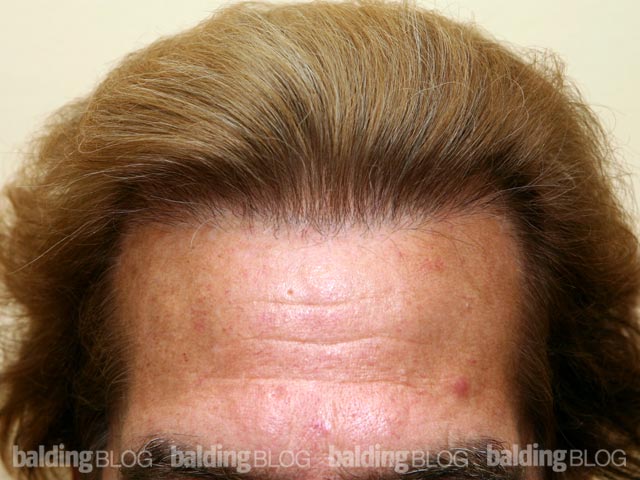
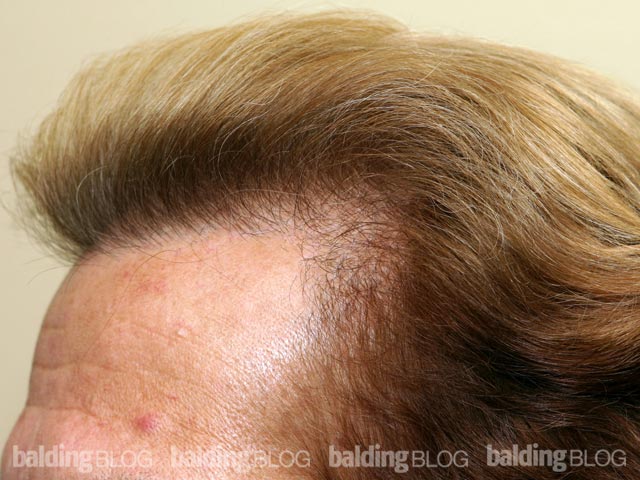
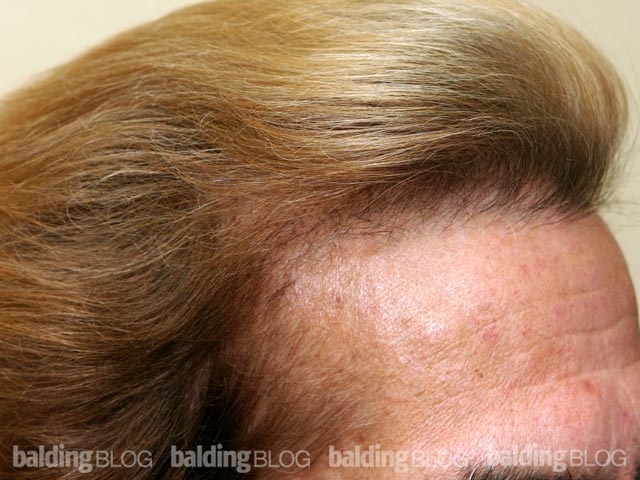
 This patient is a full Class 7 pattern of balding who has kept the forelock for his 60+ years. Recently, he started to lose the frontal hair, worse in the corners. He was happy with the man he watched in the mirror every day, up until he started to lose his hair. I thought that I would share his appearance with you. This is clearly an unusual genetic variation of the Class 7 balding pattern. He has had no hair restoration work.
This patient is a full Class 7 pattern of balding who has kept the forelock for his 60+ years. Recently, he started to lose the frontal hair, worse in the corners. He was happy with the man he watched in the mirror every day, up until he started to lose his hair. I thought that I would share his appearance with you. This is clearly an unusual genetic variation of the Class 7 balding pattern. He has had no hair restoration work.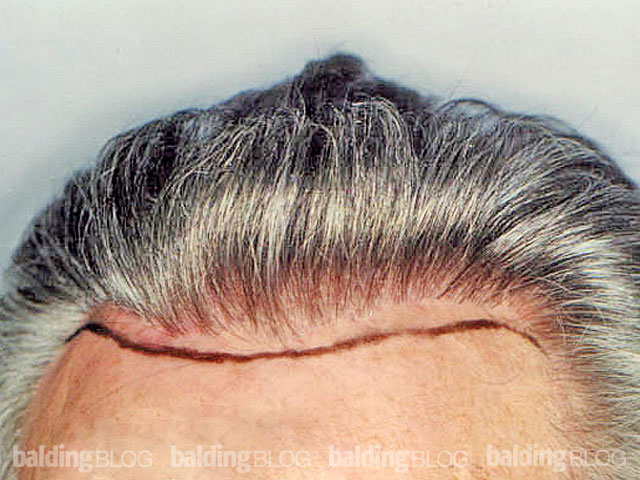
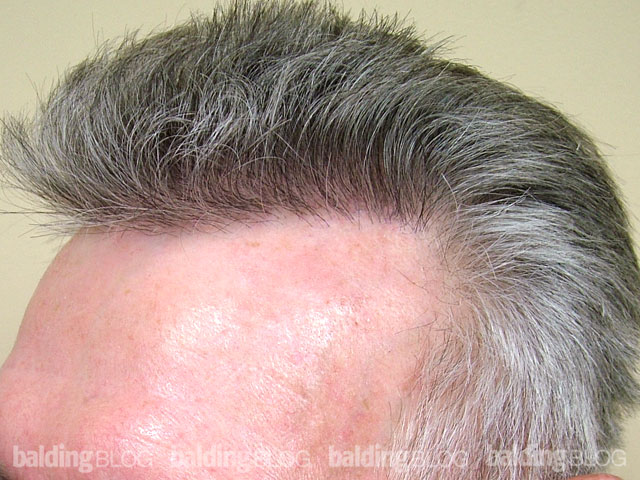
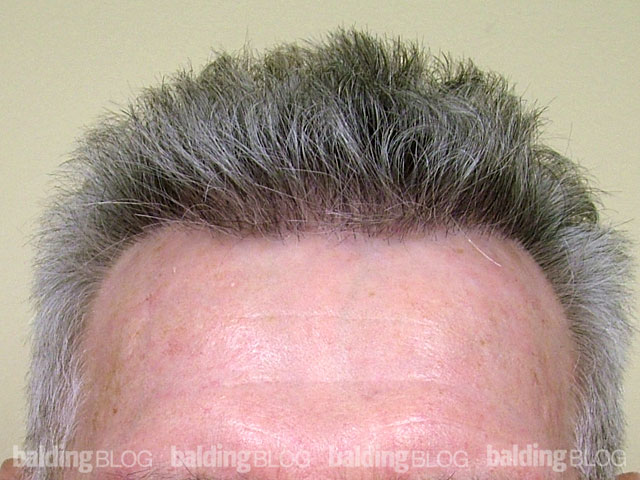
 Alternatively, some men create bouffants, a puffed up hairdo which is made up by very long hair that is wrapped around the top of the head to look like a normal head of hair. Some of these bouffants are truly amazing and they have often fooled me when they came into the office. Most of these man are either Class 6 or 7 patients and they work the frontal hair, hair by hair, to stick to the upper part of the forehead and combing the hair from behind to a forward direction so that the actual hairline does not show. I remember one man who took it one step further — he cut his hair and let it settle on his bald scalp. I am not sure how it started, but when I saw him, he had a pile of loose hairs, held by the dirt and grime of Los Angeles, to the bald area of his scalp. It worked, at least for the top and crown of his head, but not for the front of his head. This poor man never washed his hair, because the hair would all go down the drain. He used a type of perfume to neutralize any odor from his hair, which actually smelled musty.
Alternatively, some men create bouffants, a puffed up hairdo which is made up by very long hair that is wrapped around the top of the head to look like a normal head of hair. Some of these bouffants are truly amazing and they have often fooled me when they came into the office. Most of these man are either Class 6 or 7 patients and they work the frontal hair, hair by hair, to stick to the upper part of the forehead and combing the hair from behind to a forward direction so that the actual hairline does not show. I remember one man who took it one step further — he cut his hair and let it settle on his bald scalp. I am not sure how it started, but when I saw him, he had a pile of loose hairs, held by the dirt and grime of Los Angeles, to the bald area of his scalp. It worked, at least for the top and crown of his head, but not for the front of his head. This poor man never washed his hair, because the hair would all go down the drain. He used a type of perfume to neutralize any odor from his hair, which actually smelled musty. 

